In the aftermath of scandals, bans, and boardroom chaos, Juventus began the 2023/24 season with cautious optimism. Massimiliano Allegri had steadied the ship, guiding the club to a top-three finish and domestic silverware despite heavy limitations. But with a new vision focused on youth development and modern football, the Old Lady turned to one of Serie A’s rising managerial stars: Thiago Motta. His appointment symbolized a bold reset — progressive football, player development, and long-term planning. Yet, within eight months, that vision collapsed. This is the story of how Juventus’ ambitious rebuild unravelled — and how one of Italy’s biggest clubs fell out of sync with its chosen architect.
Juve’s Situation in 2023
Despite having been docked ten points the previous season, hit with a ban from all UEFA competitions, and slapped with a transfer ban for alleged financial misconduct, Juventus were still doing well in the 23/24 season under Massimiliano Allegri. Less key figures stepped up to fight for the team, like Weston McKennie and Rabiot. The transfer ban also pushed Juve to focus on strengthening their youth team, hoping to promote younger players into the senior squad. This led to talents like Yildiz and Fagioli being pushed into the first team.
The result? By matchday 20, Juve were just two points shy of the top of the Serie A table. Fast forward to the end of the season, and Juventus finished 3rd. After winning the Coppa Italia Final, Allegri had a meltdown on the touchline, leading to his sacking.
By contrast, Thiago Motta, in his second season with a young, exciting Bologna side, managed to guide them to a Champions League spot. With Juventus looking to focus more on young, upcoming players and moving on from older figures like Di Maria, Juan Cuadrado, and Pogba, they saw Motta as the man to lead this transition. After backing him in the transfer window and tying him to a long-term contract, it seemed like a match made in heaven: a coach who had thrived with youth, one of Italy’s biggest clubs shifting policy, and long-term vision.
But only eight months into the project, and with only three league defeats by matchday 25, Thiago Motta was sacked. Which raises the question: what went wrong?
Time Under Allegri
Allegri was brought back to stabilize the ship, given all the problems Juventus faced on and off the pitch. His second spell wasn’t easy: he lost key players like Ronaldo (who initially said he’d stay, even played the first game, then left for Manchester United), and Pogba, who was ruled out for doping after already struggling with injuries. Plus, injuries to Vlahović and Chiesa didn’t help either.
Allegri faced a tough challenge trying to make Juventus competitive, but as the saying goes, “a bad carpenter blames his tools.” Turns out Allegri was a very good carpenter. Despite not winning the Serie A title, he guided them to a 3rd-place finish, Club World Cup qualification, and a Coppa Italia trophy.
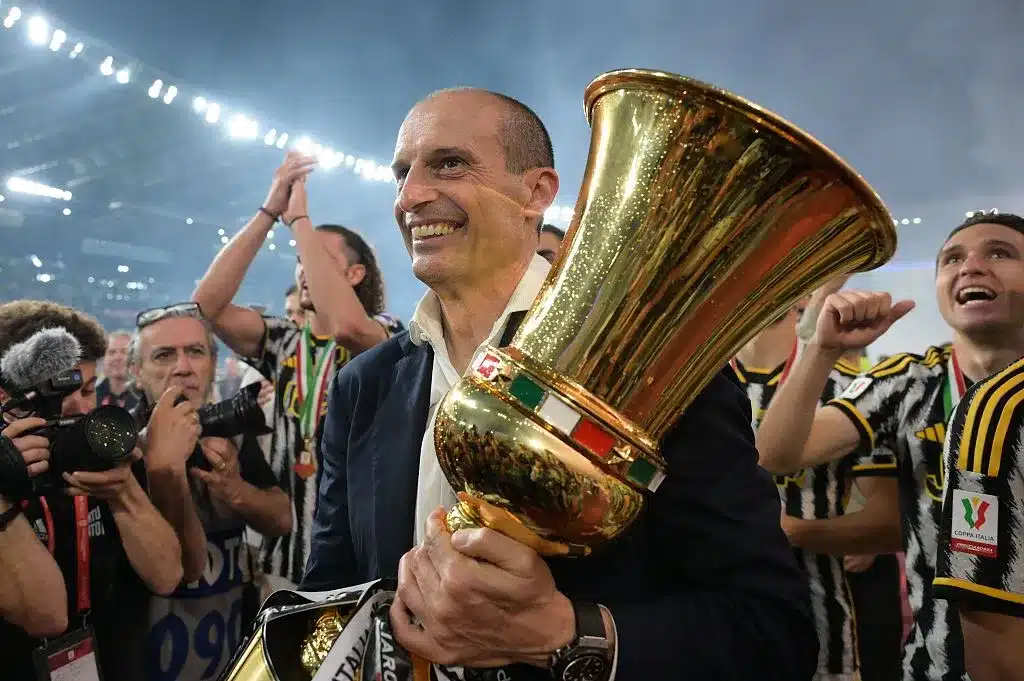
The biggest problem? Fans felt his approach was too pragmatic. Allegri prioritized defensive solidity above all else. Even though Juve finished 3rd, fans weren’t happy because the style of play was defensive and most wins were narrow 1-0 victories.
Looking at Allegri’s tactics: he typically used a 3-5-2. Allegri wasn’t a possession-based manager, ranking mid-table for possession. His strength was defense. His wingbacks would drop back to form a back five, while a forward would drop into midfield, creating a 5-4-1. Juve set up a low-block, with most tackles coming in their own third. Once they won the ball, they transitioned quickly to hurt teams drawn into their half.
Under Allegri, Juventus averaged under 50% possession and defended for large periods. Fans tolerated this while results came, but when performances dropped after January and Inter pulled away the mood soured. Allegri’s tension with the board culminated during the Coppa Italia final meltdown, and despite winning that night, he was sacked for his behavior.
Motta’s Time
After sacking their most successful manager, Juventus shifted their transfer policy. They moved from chasing seasoned players to building a younger team, creating a direct pipeline from their academy (competing in Serie C) to the first team, similar to Real Madrid Castilla or La Masia.
Juventus thought Thiago Motta was the man for the transition. At Bologna, Motta had built an exciting, possession-based team, utilizing players like Zirkzee and guiding them to the Champions League. Seeing his success and Juve’s new direction, it seemed a perfect match: a highly decorated ex-player (28 titles) turning into a promising manager.
But eight months in, despite only three league losses by matchday 26, Motta was dismissed. Juventus felt he hadn’t met expectations. So what went wrong?
Thiago Motta’s Famous 2-7-2 Formation and Managerial Inspirations
Thiago Motta is known for his unconventional “2-7-2” idea, mentioned in his UEFA Pro thesis, The Value of the Ball. To the average fan, it sounds bizarre but it’s meant to be read left-to-right (across the field) rather than back-to-front. Each flank has two players, with seven players crowding the middle, including the goalkeeper acting as the first midfielder.

Motta’s main inspirations were Marcelo Bielsa’s Leeds for collective trust and tactical discipline and Joachim Löw’s 2014 Germany for the idea that all players should think about attacking while defending and defending while attacking. Motta fused these ideas, along with experience under coaches like Mourinho and Gasperini, to create his own philosophy based on three principles:
- Confidence in possession, allowing player creativity.
- Maintaining and seeking possession.
- Recovering the ball as quickly as possible.
Tactics at Bologna vs. Juventus
Bologna
At Bologna, this philosophy translated into a possession-based system, ranking top 5 for possession and top 3 for most passes completed in Serie A. But having the ball alone isn’t enough. So how did Motta use it?
Bologna started in a 4-2-3-1. One pivot would rotate higher, while the other stayed deep. The goalkeeper’s involvement in build-up play was crucial. By holding the ball deeper, they lured opposition pressure, isolated defenders, and exploited space through third-man combinations.
In goal kicks, CBs would split either side of the keeper, fullbacks stayed deep, and CBs sometimes rotated into midfield to recreate a double pivot. Fullbacks would tuck inside while wingers dropped deeper. Once they broke the press, Bologna often shifted into a 3-2-5 shape: fullbacks tucked in, a CB joined the DM, CMs occupied half-spaces, and wingers stayed high and wide.
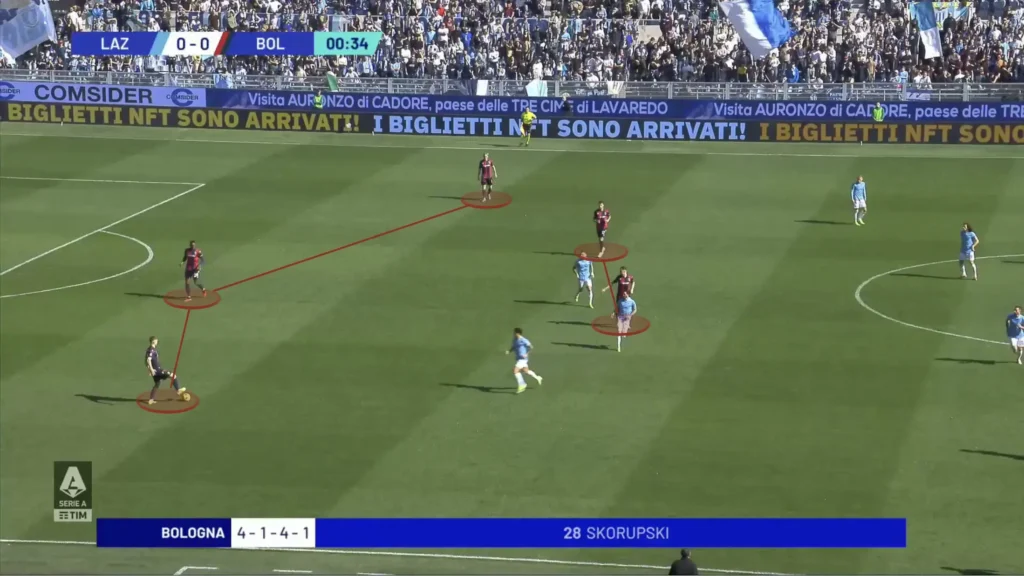
Joshua Zirkzee, the striker, had freedom to drop deep, link play, and create chances, his heat maps showed more activity in midfield areas than upfront. The results? Zirkzee ranked in the top 90% for xG and 85% for xA, and won Serie A Young Player of the Year.
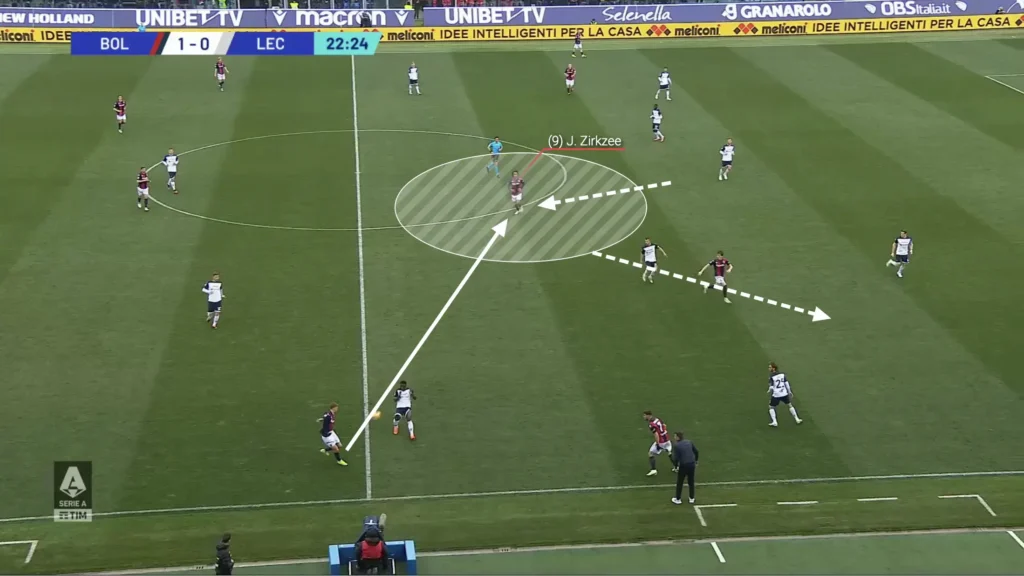
Defensively, Motta’s Bologna pressed high, forcing opponents long, maintaining a 1+3 advantage to intercept balls. If the counter-press failed, Bologna dropped into a compact 4-2-3-1, forcing teams to play centrally.
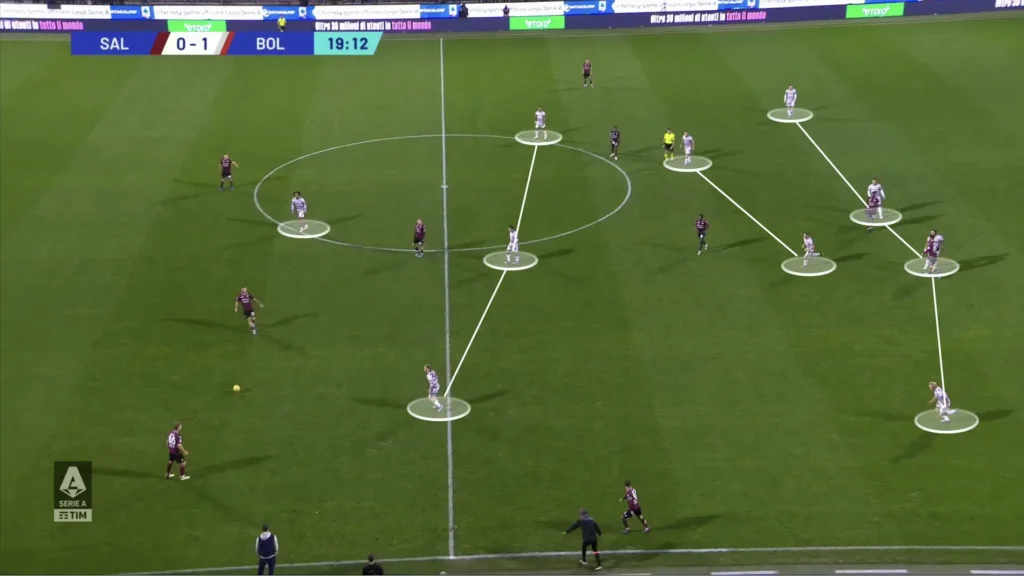
Juventus
At Juventus, Motta used a similar system but adjusted for the different striker profile. Vlahović stayed higher up, while midfielders dropped deep instead. Juventus had the second-highest possession and were top 3 in passes attempted and completed.
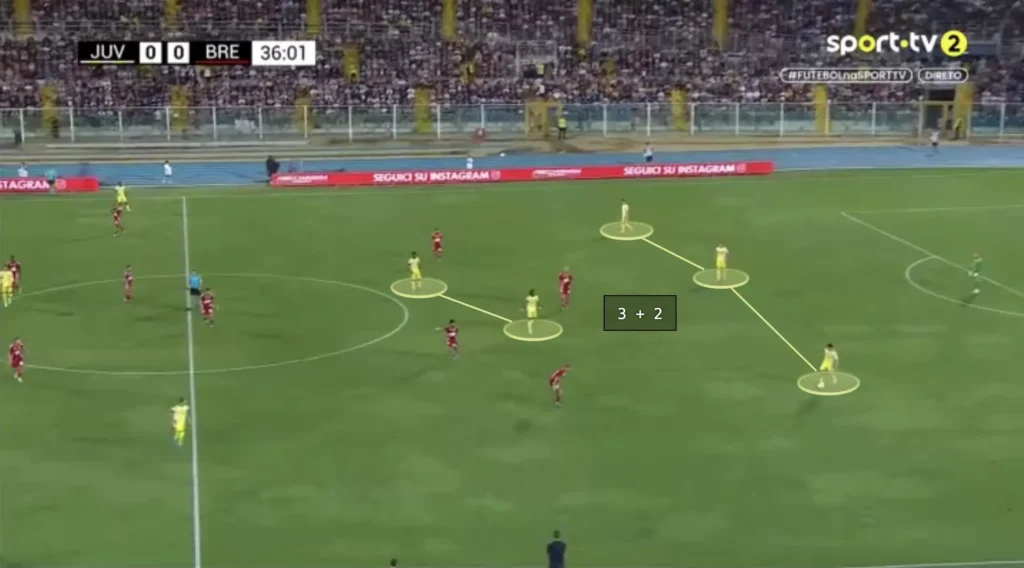
Things started well: 3-0 back-to-back wins to start the season and a comeback win against Leipzig in the Champions League. But during that Leipzig match, key defender Gleison Bremer tore his ACL, ending his season and Juve’s defensive stability took a major hit.
Despite scoring goals, Juve began dropping points. By January, though, they had won five straight games and fans started dreaming of a title push 51 points, only 7 behind Inter. Then came the collapse.
Juve were knocked out of the Champions League play-offs by PSV and dumped out of the Coppa Italia by relegation-battling Empoli (who rested key players). Motta’s constant lineup changes hurt team chemistry: Weah played five different positions, McKennie six. Seven different players wore the captain’s armband during the season. Reports of fallouts with key players like Vlahović (still the club’s top scorer despite reduced minutes) surfaced.
The results? The team looked slow, uninspired. The breaking point came with a 4-0 home loss to Atalanta, Juve’s worst home defeat since 1967 followed by a 3-0 away loss to Fiorentina, with former Juve players like Kean and Fagioli shining.
With doubts about even making the top 4, Juventus sacked Motta on March 23 and appointed Igor Tudor as his replacement.
Conclusion
Motta’s time at Juventus was strange. They got off to a decent start, but things quickly soured with fans, players, and the board. Freezing out top scorer Vlahović, losing the dressing room and constant tinkering it all led to Motta leaving with a win rate under 45%, ranking him among the bottom three managers in Juventus history.
His reputation took a hit, but a job at a mid-table club or a move outside Italy could help him rebuild and remind people why he was once considered one of Europe’s most promising managers.
